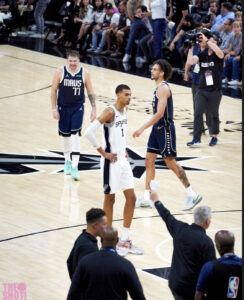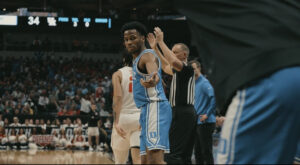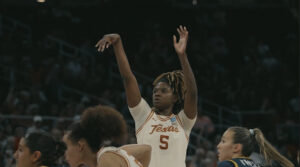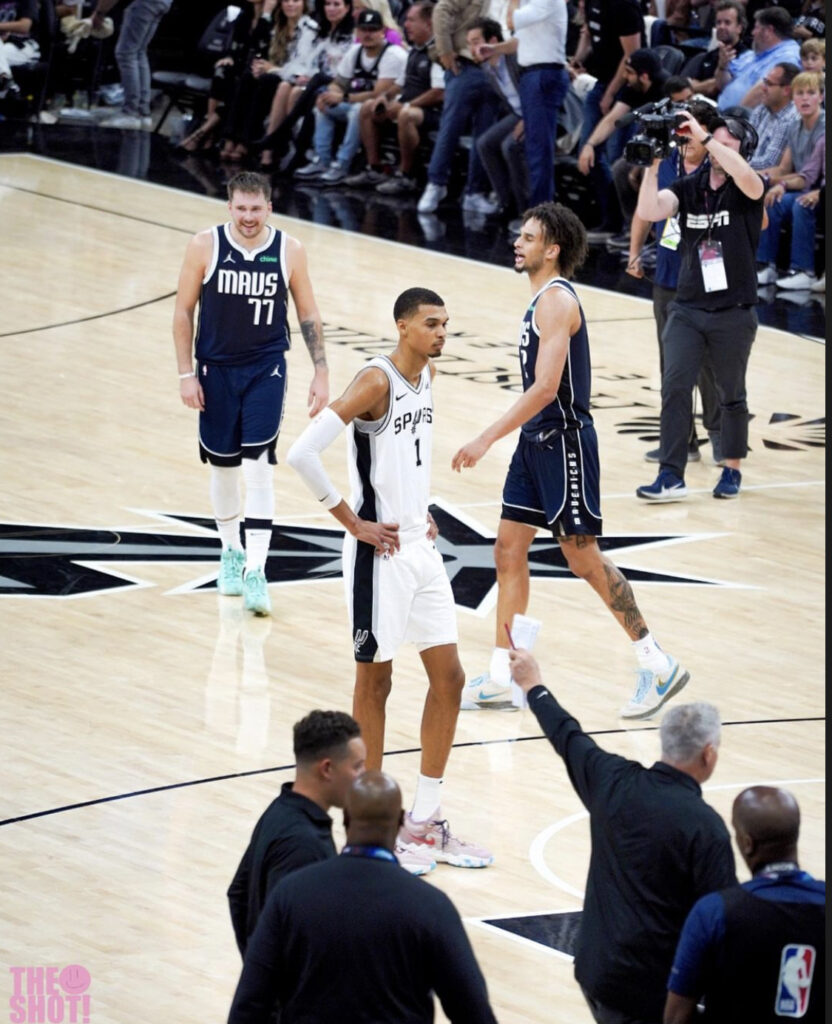The media has completely changed a league that was once centered around on the court play and team performance. Nowadays what happens on the basketball court takes a backseat to off the court drama, postgame quotes, and narratives that have little to do with professional basketball. So much of what happens on the court is now dictated by what the media says and the players are conscious of various narratives and storylines that the media creates within any given National Basketball Association (NBA) season. These narratives have many implications that aren’t usually talked about when discussing the NBA as a whole.

The media negatively affects the NBA in many ways. First the media tends to sensationalize different events/quotes within the season. This done to to attract viewership and engagement with their posts. This type of sensationalism doesn’t just happen in the articles that are made by beat writers. Other more modern versions of media such as Instagram pages, TikTok accounts, and Twitter accounts that are run by these major outlets like ESPN, Bleacher Report, House of Highlights and they are one of the biggest culprits of this form of sensationalism. These pages spew off “hot takes” for the sake of increasing engagement on the post. While this may seem like a harmless form of increasing popularity, the long-term effects of this kind of media coverage are evident when you read between the lines. A lot of these engagement farming posts are consumed by the casual fan that isn’t as invested in the league as other, more die-hard individuals. As a result, the general perception of a team/player can be affected by these incendiary posts. The casual viewer won’t know how to differentiate the posts that are farming engagement from the reality of the featured team or player. As a result, a large portion of the casual fan population become uninformed on various topics within the NBA.

This negative coverage largely affects the overall perception of the league itself. If media members are consistently degrading the skill level and performance of the players within the league, it will lead to the league itself being seen as producing a low-quality product. One of the most glaring examples of this dynamic is the media’s constant need to call the NBA an offensive-minded league where no defense is played. This is a lazy narrative that glosses over the fact that the league has collectively become more skilled compared to the NBA of the 1980s/90s. This narrative also conveniently ignores the boom in three-point shooting that occurred between 2015-2018. Lazy narratives like this led to the NBA as a league being seen in a light that simply isn’t accurate.
On the flip side, some may argue that this negative coverage of the league isn’t all bad, as it leads to an increase in the overall popularity of the NBA and its star players. While this may be true if we’re looking at it from a pure engagement and popularity standpoint, but there are many downsides to having this kind of media coverage. For one, negative exposure can affect the NBA’s relationships with sponsors, advertisers, and partners. Companies may hesitate to associate their brand with a league that is embroiled in controversy or negative publicity, leading to loss of sponsorship deals and revenue. NBA players often have individual endorsement deals with various brands.
Negative exposure for the league can spill over to affect players’ endorsement deals. Sponsors may be reluctant to renew contracts or may terminate existing deals if they believe their brand is at risk due to negative association with the NBA. This is especially evident in the NBA where, “unlike baseball and especially football, in basketball the players’ faces are easy to see and thus easy to use in advertisements,” which creates a “clearer identification between fans and individual players.” 1
Because of this, the NBA’s presence in media and TV is much larger than other leagues such as the National Football League or the Major League Baseball. The NBA has the most marketable stars in all of sports because of how present any given player is throughout the season. Players play 82 games, giving advertisers time to structure ad campaigns and sponsorships centered on them. Often these players are very generous with their donations to non-profits within the local community and these endorsement deals are often relevant and important to the community for this reason.
NBA players are in the limelight now more than ever. The popularity of the average NBA is much higher than it was 20 years ago with the rise of social media. These players’ lives are looked at under a microscope. One of the many skills that young basketball players are taught is how to respond to and interact with the media. “You’re, in all humbleness, a big-time athlete, and I mean, in our case, we’re in the NBA, and it’s a dream for a lot of people. And so that means a lot of people are watching,” Gradey Dick adds. “So, people are gonna try everything they can to just find different things out about you.” 2
Many programs, most notably Overtime Elite, a startup basketball league that is run by Overtime, a popular media outlet that covers all sports, makes it a point to train their young players on how to handle the media. The media has become a staple of NBA players’ lives with the increase for the demand of fan interaction and engagement on social media. As expected, players respond differently to this new age of NBA culture. Reigning NBA MVP Nikola Jokic has expressed his discomfort with the intrusive nature of NBA fans and has generally tried to stay away from the public eye. “Being famous, some people like it, some people don’t. When I finish my career, I really wish nobody knows me,” Jokic said. “I really don’t like this life because, at the end of the day, we are just basketball players. We are just good at what we are doing. But the media is something that is around us, and, of course, we are getting paid because of the media, because of our popularity.” He added: “It just feels sad, whenever you go to the bar, restaurant, some game, people are just taking their phones out and trying to record you. I think that’s really, I’m going to say, rude. It’s not that I’m out showing myself; I’m just who I am.” The league and its organizations are actively working against this rising tide, trying to figure out how to keep information in-house before it gets leaked to the public and spirals into something much bigger — something that could have a significant impact on how the organization is viewed or even how the players perform on the basketball court.” 3
This relationship between the players and the media becomes much more complex when discussing what the players can and can’t talk about. For example, NBA Dallas Mavericks point guard Kyrie Irving has been outspoken when it comes to voicing his support for various causes and movements that he agrees with. When Irving played for the Brooklyn Nets, he was required by New York law to receive the COVID vaccine to play at the Barclay’s Center, the home court of the Brooklyn Nets. Irving publicly rejected this request and sat out for the rest of the season. While NBA players are encouraged to support movements that are generally viewed as good and worthwhile, they have been ridiculed for supporting causes that aren’t unanimously viewed as positive. This begs the question of how many liberties NBA players really have, and if the league is really entitled to players’ participation in the media. Players generally stay within the “gray area” when it comes to speaking about controversial topics to the media. “Players’ neutrality favored the NBA and their respective eco- nomic futures in the league by seemingly kowtowing to Chinese national interests 4. Between the U.S. and China, the NBA struggled to appease one side without alienating the other 5”. The NBA is currently trying to find a balance with what they allow their players to say or speak about. They want to empower their athletes to be outspoken about causes they support, but sometimes these causes don’t align with the views of the league itself.

In conclusion, the relationship between NBA players and the national media is growing and evolving with each passing season. As players get used to the tactics and methods of the media, they will be more equipped to deal with the problems that are caused by these outlets. While media exposure can increase visibility and fan engagement, not all exposure is beneficial. Negative media coverage can damage the league’s reputation, affect player image and marketability, and strain relationships with sponsors and partners. It’s essential for the NBA to navigate these challenges by promoting responsible journalism, prioritizing player empowerment, and addressing issues that arise with transparency and integrity. By doing so, the league can continue to thrive while mitigating the negative effects of media scrutiny, ensuring a positive and sustainable future for the NBA and its stakeholders.
- Secular, Steven. The Digital NBA: How the World’s Savviest League Brings the Court to Our Couch. University of Illinois Press, 2023. ↵
- The Guardian (London, England). 2024. “‘Nothing Is Sacred’: NBA Players Are in the Public Eye like Never before; Social Media Runs the World, Celebrity Culture Runs Social Media, and NBA Players Are More Famous than Ever. All of It Has given Rise to Privacy Concerns Unthinkable Even a Decade Ago,” ↵
- The Guardian (London, England). 2024. “‘Nothing Is Sacred’: NBA Players Are in the Public Eye like Never before; Social Media Runs the World, Celebrity Culture Runs Social Media, and NBA Players Are More Famous than Ever. All of It Has given Rise to Privacy Concerns Unthinkable Even a Decade Ago” ↵
- Burroughs, Benjamin. “‘Stick to Sports’ and Critical Sports Media Industry Studies.” ↵
- Burroughs, Benjamin. “‘Stick to Sports’ and Critical Sports Media Industry Studies.” ↵


